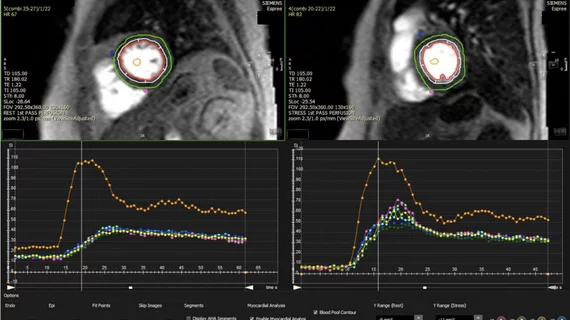Imaging group thrilled with new CPT codes for MBFR measurements
The American Medical Association (AMA) recently announced two new Current Procedural Terminology (CPT) Category III codes for reporting absolute quantitation for myocardial blood flow for cardiac MRI services. The new codes go into effect on July 1.
This update was designed to facilitate appropriate coding for stress cardiac magnetic resonance (CMR) services in patients with obstructive coronary artery disease (CAD) who have stable chest pain symptoms. This is for patients undergoing either stress PET myocardial perfusion imaging (MPI), or stress CMR that includes an assessment with myocardial blood flow reserve (MBFR), which enables measurement of coronary microvascular function.
MBFR can help better assess patients with nonobstructive CAD, including ischemia with no obstructive coronary arteries (INOCA). This is useful to improve diagnosis accuracy and enhance risk stratification. It is widely accepted as an option for the evaluation of chest pain, and is outlined in the most recently published, multi-societal 2021 AHA/ACC/ASE/CHEST/SAEM/SCCT/SCMR Guideline for the Evaluation and Diagnosis of Chest Pain.
CMR with the addition of MBFR is listed as a Class 2A recommendation in the guidelines for patients with obstructive CAD and those known to have unobstructive CAD who present with stable chest pain.
SCMR sees codes as a step forward
The Society for Cardiovascular Magnetic Resonance (SCMR) said its efforts to develop a coding strategy to enhance and modernize medical coding practices in MRI has led to the introduction of these new codes. MBFR has been touted by MRI and nuclear cardiology experts for adding additional diagnostic information to enable more accurate diagnoses.
"These new codes are the result of work by SCMR’s U.S. advocacy team, in collaboration with both the American College of Cardiology and the American College of Radiology, reflecting our commitment to updating the coding strategy for CMR services," SCMR said in statement.
SCMR also said it is planning a series of webinars to explain this update in more detail to its members.
Details on the new CRM CPT codes
• CPT code +0899T is for noninvasive determination of absolute quantitation of myocardial blood flow (AQMBF), derived by augmentative algorithmic analysis of the dataset acquired via contrast CMR, pharmacologic stress, with interpretation and report by a physician or other qualified healthcare professional (List separately in addition to code for primary procedure)
• CPT code +0900T is for noninvasive estimate of absolute quantitation of myocardial blood flow (AQMBF), derived by assistive algorithmic analysis of the dataset acquired via contrast CMR, pharmacologic stress, with interpretation and report by a physician or other qualified healthcare professional (list separately in addition to code for primary procedure).
CPT Category III codes are not designed for reimbursements
Unlike billable CPT Category I codes, CPT Category III are temporary codes that allow for data collection for emerging technologies, services, procedures and service paradigms for clinical efficacy, utilization, and outcomes. The codes are intended to be used for data collection to substantiate widespread usage of a technology or service, and in some cases to determine if there should be payment for new services and procedures that currently do not meet the criteria for a Category I code.
The new codes will be published in the 2025 edition of the AMA CPT Code Book.

